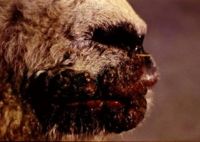Orf
Also know as: Contagious Pustular Dermatitis — CPD — Contagious Ecthyma — Scabby Mouth
Introduction
Orf is the most common viral zoonosis in the UK. It causes an acute debilitating but rarely fatal skin disease of sheep, goats and incidentally of ruminants and humans. It is a Parapox virus of the family Poxviridae and infects by entering a skin lesion in places such as the udder, mouth and throat. These lesions then coalesce to form scabbed masses. It is of particular concern in lambs as mouth lesions prevent them from suckling due to pain. If the sheep has lesions on her udder she is also unlikely to want to let her lambs suckle.
The virus is a large, enveloped, highly epitheliotropic, DNA virus which is ovoid in shape and measures 220‑300 x 140‑170 nm and there are over 100 polypeptides in the virion. The core proteins include a transcriptase and several other enzymes. The virus is immunologically related to those causing bovine papular stomatitis, pseudocowpox, sealpox, deer PPV, red squirrel PPV and camel PPV. There is extensive cross‑neutralization and cross‑protection between viruses belonging to the same genus, but not between those of different genera.
Morbidity in a flock may reach 90% but mortality is incredibly rare, reaching 1% maximum, unless secondary myiasis (blowfly strike) occurs. The course of the disease without complications is 2‑6 weeks, and it takes about 10 weeks to run a course through a naive flock, but often lingers indefinitely in the flock because it can reinfect the same animal many times and is resistant to desiccation.
Clinical Signs
Failure to gain weight in lambs, plus the presence of scabby lesions on the mouth. Similar lesions on the mouth and udder of ewes and a reluctance to eat in these animals. In man, papules and pustules develop on hands within 10 days, enlarge and then regress after several weeks.
Diagnosis
The virus can be identified by direct electron microscopy of samples from fresh lesions.
Differential diagnoses include Sheep Pox, which is a more severe disease characterized by elevated papules distributed diffusely over the skin surface and high mortality rates are seen. Ulcerative dermatosis is another differential and is also characterized by ulcers and crusts on the skin of the face, feet and genitalia, however the lesions are not elevated because there is no epithelial hyperplasia. Bluetongue Virus is another differential. There is lower morbidity but a high mortality and the disease is usually seen in adult animals. Mycotic dermatitis is a differential although the scabs are smaller and thinner and lighter and usually yellowish in color, with crusts not firmly attached. Foot and mouth disease can be a differential when lesions occur in the mouth.
Control
Attenuated virus can be applied by scarification to axillar or tail base, causing scabs to fall off in 30 days. Annual vaccination of ewes at least 8 weeks before lambing (all in contact should be done simultaneously) is required. In an outbreak, all lambs can be vaccinated .
| Orf Learning Resources | |
|---|---|
To reach the Vetstream content, please select |
Canis, Felis, Lapis or Equis |
 Test your knowledge using flashcard type questions |
Sheep Medicine Q&A 05 |
References
Blood, D.C. and Studdert, V. P. (1999) Saunders Comprehensive Veterinary Dictionary (2nd Edition) Elsevier Science
Bridger, J and Russell, P (2007) Virology Study Guide, Royal Veterinary College
Radostits, O.M, Arundel, J.H, and Gay, C.C. (2000) Veterinary Medicine: a textbook of the diseases of cattle, sheep, pigs, goats and horses Elsevier Health Sciences
| This article has been peer reviewed but is awaiting expert review. If you would like to help with this, please see more information about expert reviewing. |
Error in widget FBRecommend: unable to write file /var/www/wikivet.net/extensions/Widgets/compiled_templates/wrt6969bab03f3ed6_06736831 Error in widget google+: unable to write file /var/www/wikivet.net/extensions/Widgets/compiled_templates/wrt6969bab044f430_31381104 Error in widget TwitterTweet: unable to write file /var/www/wikivet.net/extensions/Widgets/compiled_templates/wrt6969bab04b3459_59991332
|
| WikiVet® Introduction - Help WikiVet - Report a Problem |
